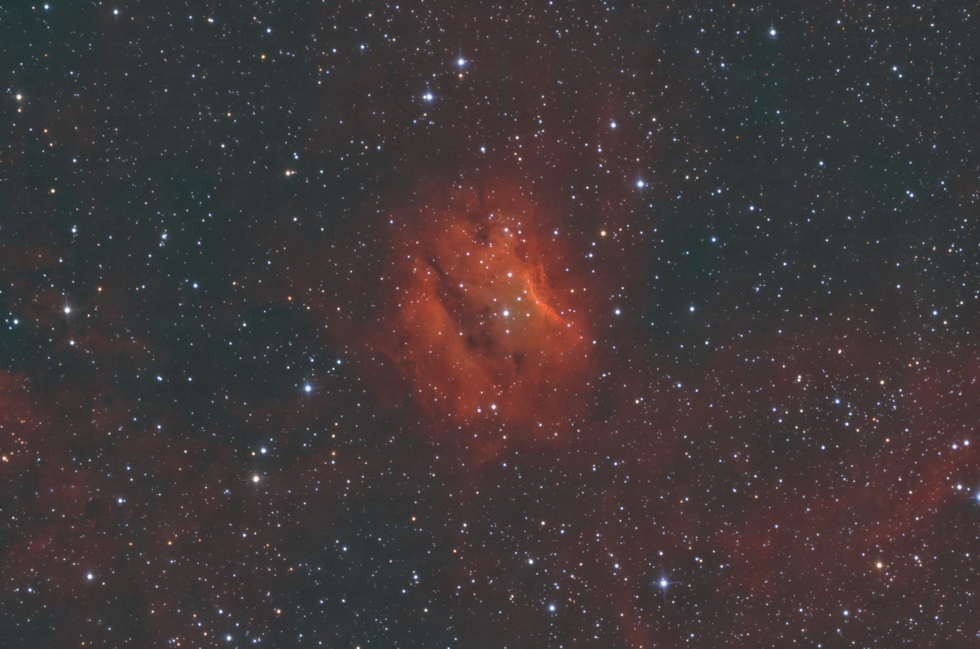RCW 98 – COFFEE BEAN NEBULA - Dynamic SHO palette
RCW 98 – COFFEE BEAN NEBULA - Dynamic SHO palette
Due to the bad weather, for over two months, I decided to subscribe to a remote telescope service; so, I can now process some pictures of objects not visible from my home observatory.
Looking for some interesting objects, I found this uncommon HII region; it’s included only in the RCW Catalogue (Rodgers, Campbell and Whiteoak).
The emission nebula RCW98 is a cloud of interstellar gas located in the constellation of Centaurus, about 10,000 light-years away from Earth Its shape is irregular and shows several bright and dark regions, due to the presence of dust that partially obscures the light of the stars.
The nebula is ionized by at least three stars of unknown spectral type, named ALS 19450, ALS 19451, and ALS 19452, that emit ultraviolet radiation that excites the atoms of hydrogen, helium, oxygen, and other elements present in the gas. The color of the nebula ranges from red to blue, depending on the chemical composition and ionization level.
The nebula is part of a large star-forming region that also includes the nearby clouds RCW 97 and RCW 99 In its direction there is also an infrared source, IRAS 15033-5736, that could be associated with a young star, or a star cluster hidden by dust.
RCW98 is an example of how stars influence their surrounding environment, shaping the clouds of gas and dust from which they were born and creating spectacular scenarios in the night sky.
I developed the picture using (for the first time) a Dynamic SHO palette, which uses factors based on pixel values (instead of mean values). The image resulting has more color deepness.
Looking for some interesting objects, I found this uncommon HII region; it’s included only in the RCW Catalogue (Rodgers, Campbell and Whiteoak).
The emission nebula RCW98 is a cloud of interstellar gas located in the constellation of Centaurus, about 10,000 light-years away from Earth Its shape is irregular and shows several bright and dark regions, due to the presence of dust that partially obscures the light of the stars.
The nebula is ionized by at least three stars of unknown spectral type, named ALS 19450, ALS 19451, and ALS 19452, that emit ultraviolet radiation that excites the atoms of hydrogen, helium, oxygen, and other elements present in the gas. The color of the nebula ranges from red to blue, depending on the chemical composition and ionization level.
The nebula is part of a large star-forming region that also includes the nearby clouds RCW 97 and RCW 99 In its direction there is also an infrared source, IRAS 15033-5736, that could be associated with a young star, or a star cluster hidden by dust.
RCW98 is an example of how stars influence their surrounding environment, shaping the clouds of gas and dust from which they were born and creating spectacular scenarios in the night sky.
I developed the picture using (for the first time) a Dynamic SHO palette, which uses factors based on pixel values (instead of mean values). The image resulting has more color deepness.
SPECIFICATIONS
Telescope
Planewave CDK24
Camera
QHY 600M Pro
Location
El Sauce Observatory - Río Hurtado, Coquimbo Region, Chile
Date of observation
From 13 May 2023 to 19 May 2023
Filters
HOS
Processing
Pixinsight
Credits
Massimo Marchini processing; Telescope Live calibrated data


